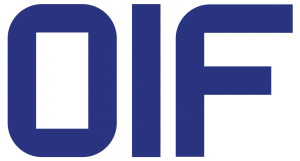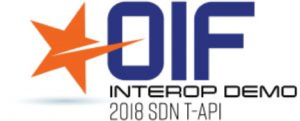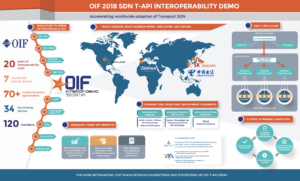OIF Members to Demonstrate Interoperability of Industry’s Hottest Technologies at OFC 2019
Multi-vendor live demos to feature 400ZR, CEI-112G and FlexE technology; OIF experts to lead panel discussions on hot topics, interoperability
Fremont, Calif.—February 20, 2019 – Demonstrating how interoperability works get done, 13 OIF member companies will participate in live interoperability demos of the industry’s hottest technologies – 400ZR, Common Electrical I/O (CEI)-112G and Flex Ethernet (FlexE) – at OFC 2019 in San Diego, March 5-7, 2019.
Amphenol, Cisco Systems, Credo Semiconductor (HK) LTD, Finisar, Inphi, Juniper Networks, Keysight Technologies, Molex, Spirent Communications, TE Connectivity, VIAVI Solutions, Xilinx and YAMAICHI ELECTRONICS will demonstrate the interoperability of their products and technologies in OIF’s booth, #6215.
“400ZR, CEI-112G and FlexE are critical technologies in our industry so it’s no surprise these are the interoperability specifications our members are most focused on for OFC,” said Steve Sekel of Keysight and OIF’s Physical and Link Layer Interoperability Working Group Chair. “The live demos will demonstrate critical insight into how key technologies interoperate within the industry’s ecosystem.”
400ZR Demo
OIF’s 400ZR project is critical in facilitating the reduction of cost and complexity for high bandwidth data center interconnects and promoting interoperability among optical module manufacturers. Currently in progress, the project will result in an implementation agreement for 400G ZR and short-reach DWDM multi-vendor interoperability. The 400ZR demo consists of real-time Error Vector Magnitude measurements demonstrating the maturity of the methodology used for transmitter specifications. In addition, a hardware-based 400ZR installation will show how participants communicate a typical application case.
CEI-112G Demo
OIF is taking a lead role in moving the industry to the next generation with its development of electrical interface specifications for 112 Gbps per differential pair. Multiple live demonstrations featuring interoperability clearly prove the key role OIF provides. The CEI-112G demonstrations in the OIF booth will feature multi-party silicon supplier interoperability over mated compliance board channels and direct attach copper cable channels, all demonstrating the technical viability of 112 Gbps operation, along with multiple industry form factors including OSFP and QSFP-DD.
FlexE Demo
OIF continues to lead in FlexE aggregation architectures through its newest FlexE 2.1 project for FlexE over 50GbE PHY applications, an extension to its FlexE 2.0 Implementation Agreement (IA). The FlexE 2.0 demo will show off the bonding, subrating, and channelization features that allows FlexE-enabled hardware to support non-standard Ethernet rates over standard Ethernet optics. Realistic multi-vendor deployment scenarios, client rate reconfiguration, and in-band messaging features will be demonstrated on a network built from a variety of Ethernet optics and interconnecting the OIF and Ethernet Alliance booths.
OIF @ OFC 2019 Speaking Sessions
On Thursday, March 7, industry experts from OIF will lead panels focused on the latest update on 400ZR specifications and the drivers, needs, and challenges in the evolution to widescale adoption of open, interoperable optical networks.
OIF – 400ZR Specification Update
Thursday, 7 March, 10:15-11:15 – Theater II, Hall E
Moderator: Karl Gass, OIF PLL WG Vice Chair Optical
Speakers include: Josef Berger, Inphi; Mark Filer, Microsoft Azure; Marc Stiller, NeoPhotonics and Markus Weber, Acacia Communications
The Path to Open, Interoperable Optical Networking
Thursday, 7 March, 11:15-12:15 – Theater II, Hall E
Moderator: Dave Brown, OIF Director of Communications, Nokia
Speakers include: Victor Lopez, Telefónica gCTIO; Lyndon Ong, OIF MA&E Co-Chair – Networking, Ciena and Jonathan Sadler, OIF Networking Interoperability WG Chair, Infinera
Check the status of OIF’s current work here.
About OIF
Optical Internetworking Forum (OIF) is where the optical networking industry’s interoperability work gets done. Celebrating 20 years of effecting progressive change in the industry, OIF represents the dynamic ecosystem of 100+ industry leading network operators, system vendors, component vendors and test equipment vendors, all collaborating to develop interoperable electrical, optical and control solutions that directly impact the industry’s ecosystem and facilitate global connectivity in the open network world. Connect with OIF at @OIForum, on LinkedIn and at https://www.oiforum.com/.
PR Contact:
Leah Wilkinson
Wilkinson + Associates for OIF
Email: leah@wilkinson.associates
Office: 703-907-0010



